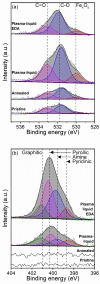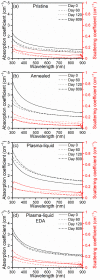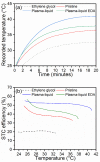Hybrid Plasma-Liquid Functionalisation for the Enhanced Stability of CNT Nanofluids for Application in Solar Energy Conversion
- PMID: 35957139
- PMCID: PMC9370158
- DOI: 10.3390/nano12152705
Hybrid Plasma-Liquid Functionalisation for the Enhanced Stability of CNT Nanofluids for Application in Solar Energy Conversion
Abstract
Macroscopic ribbon-like assemblies of carbon nanotubes (CNTs) are functionalised using a simple direct-current-based plasma-liquid system, with oxygen and nitrogen functional groups being added. These modifications have been shown to reduce the contact angle of the ribbons, with the greatest reduction being from 84° to 35°. The ability to improve the wettability of the CNTs is of paramount importance for producing nanofluids, with relevance for a number of applications. Here, in particular, we investigate the efficacy of these samples as nanofluid additives for solar-thermal harvesting. Surface treatments by plasma-induced non-equilibrium electrochemistry are shown to enhance the stability of the nanofluids, allowing for full redispersion under simulated operating conditions. Furthermore, the enhanced dispersibility results in both a larger absorption coefficient and an improved thermal profile under solar simulation.
Keywords: carbon nanotubes; plasma functionalisation; solar–thermal.
Conflict of interest statement
The authors declare no conflict of interest.
Figures










Similar articles
-
Nanofluids for Direct-Absorption Solar Collectors-DASCs: A Review on Recent Progress and Future Perspectives.Nanomaterials (Basel). 2023 Mar 30;13(7):1232. doi: 10.3390/nano13071232. Nanomaterials (Basel). 2023. PMID: 37049324 Free PMC article. Review.
-
Self-assembled Au-CQDs nanofluids with excellent solar absorption and medium-high temperature stability for solar energy harvesting.J Colloid Interface Sci. 2024 Oct 15;672:765-775. doi: 10.1016/j.jcis.2024.05.225. Epub 2024 May 31. J Colloid Interface Sci. 2024. PMID: 38870767
-
Effect of surfactants on the stability and solar thermal absorption characteristics of water-based nanofluids with multi-walled carbon nanotubes.Sol Energy. 2018 Jul;122:10.1016/j.ijheatmasstransfer.2018.01.141. doi: 10.1016/j.ijheatmasstransfer.2018.01.141. Sol Energy. 2018. PMID: 39473438 Free PMC article.
-
A Review on Recent Progress in Preparation of Medium-Temperature Solar-Thermal Nanofluids with Stable Dispersion.Nanomaterials (Basel). 2023 Apr 18;13(8):1399. doi: 10.3390/nano13081399. Nanomaterials (Basel). 2023. PMID: 37110985 Free PMC article. Review.
-
Exploring the photo-thermal conversion behavior and extinction coefficient of activated carbon nanofluids for direct absorption solar collector applications.Environ Sci Pollut Res Int. 2022 Feb;29(9):13188-13200. doi: 10.1007/s11356-021-16637-w. Epub 2021 Sep 28. Environ Sci Pollut Res Int. 2022. PMID: 34585351
Cited by
-
The Role of Nanofluids in Renewable Energy Engineering.Nanomaterials (Basel). 2023 Sep 29;13(19):2671. doi: 10.3390/nano13192671. Nanomaterials (Basel). 2023. PMID: 37836312 Free PMC article.
-
Nanofluids for Direct-Absorption Solar Collectors-DASCs: A Review on Recent Progress and Future Perspectives.Nanomaterials (Basel). 2023 Mar 30;13(7):1232. doi: 10.3390/nano13071232. Nanomaterials (Basel). 2023. PMID: 37049324 Free PMC article. Review.
References
-
- Minardi J.E., Chuang H.N. Performance of a “Black” Liquid Flat-Plate Solar Collector. Sol. Energy. 1975;17:179–183. doi: 10.1016/0038-092X(75)90057-2. - DOI
-
- Bertocchi R., Karni J., Kribus A. Experimental Evaluation of a Non-Isothermal High Temperature Solar Particle Receiver. Energy. 2004;29:687–700. doi: 10.1016/j.energy.2003.07.001. - DOI
-
- ASTM Standard Tables for Reference Solar Spectral Irradiances: Direct Normal and Hemispherical on 37° Tilted Surface 2012. ASTM International; West Conshohocken, PA, USA: 2020.
-
- Tyagi H., Phelan P., Prasher R. Predicted Efficiency of a Low-Temperature Nanofluid-Based Direct Absorption Solar Collector. J. Sol. Energy Eng. 2009;131:041004. doi: 10.1115/1.3197562. - DOI
-
- Sharaf O.Z., Rizk N., Joshi C.P., Abi Jaoudé M., Al-Khateeb A.N., Kyritsis D.C., Abu-Nada E., Martin M.N. Ultrastable Plasmonic Nanofluids in Optimized Direct Absorption Solar Collectors. Energy Convers. Manag. 2019;199:112010. doi: 10.1016/j.enconman.2019.112010. - DOI
Grants and funding
LinkOut - more resources
Full Text Sources

